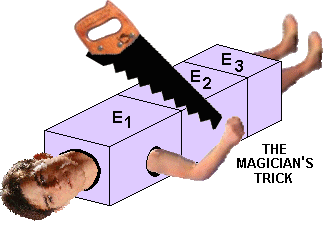|
Given Events E1 and F, write two conditional probabilities :
| P(E1 | F) = |
P(E1  F) F)P(F) |
or |
P(E1  F) = F) = |
P(E1 | F) P(F) P(F) |
|||||
| P(F | E1) = |
P(E1  F) F)P(E1) |
or |
P(E1  F) = F) = |
P(F | E1) P(E1) P(E1) |
|||||
|
|||||||||
P(E1 | F) P(F) = P(F | E1)
P(F) = P(F | E1) P(E1)
P(E1)
| Divide both sides of the above by P(F) , to get a SIMPLE FORM OF BAYES RULE : |
|
| The denominator P(F) above can be re-written if the sample space (and hence F) are partitioned, or divided, into 2 or more non-overlapping pieces, as implied in the classic box-cutting magic trick, and its representation using sets in the figures (right) : |  |
|||||||
|
Don't worry : This won't hurt at all Prefer Madonna to Josh? |
||||||||
|
If E1 , E2 , and E3 do not overlap, then
(F  E1) ,
(F
E1) ,
(F  E2) , and
(F
E2) , and
(F  E3) also do not overlap, and hence
E3) also do not overlap, and hence
P(F) =
P(F  E1) +
P(F
E1) +
P(F  E2) +
P(F
E2) +
P(F  E3) ;
re-writing each term as a product (as at the top of this page) :
E3) ;
re-writing each term as a product (as at the top of this page) :
P(F) =
P(E1) P(F | E1) +
P(E2)
P(F | E1) +
P(E2) P(F | E2) +
P(E3)
P(F | E2) +
P(E3) P(F | E3) ;
P(F | E3) ;
We can then re-write the simpler form (above) to a LARGER FORM OF BAYES RULE :
|
|


